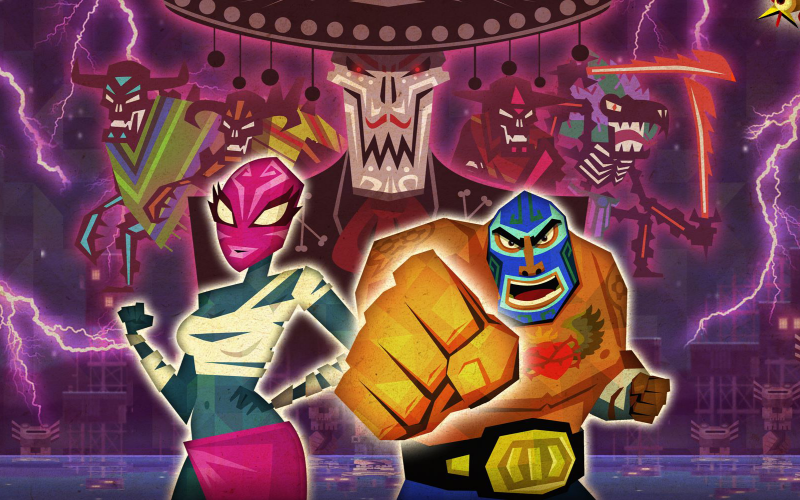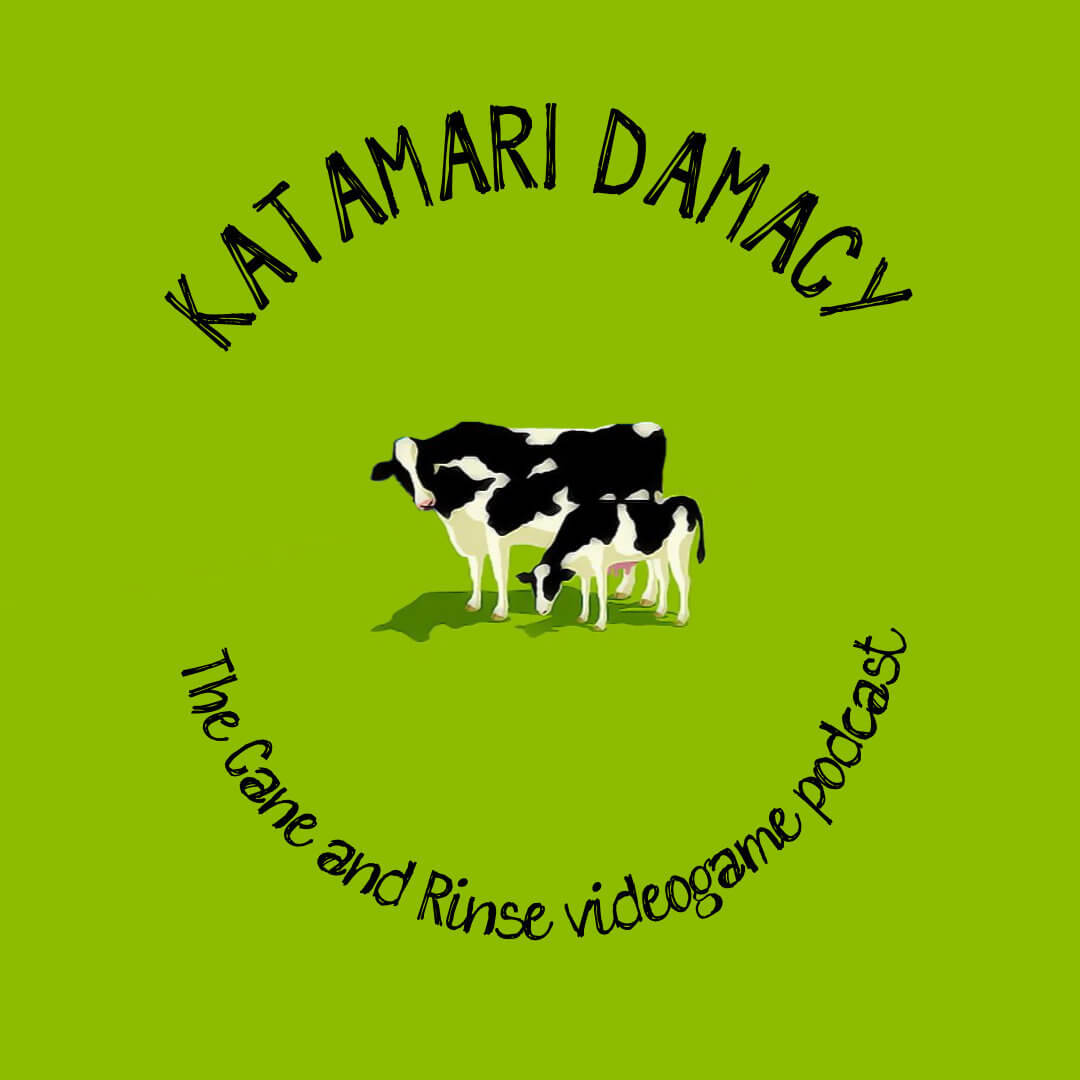Does the sequel to 2013’s Guacamelee! improve upon the original recipe, or is this avocado action underripe? Brian Edwards taste-tests…
At the end of Guacamelee! we got to see legendary luchador Juan Aguacate take down the infamous Calaca and save the Mexiverse from destruction.
At the beginning of Guacamelee! 2, we get to see legendary luchador Juan Aguacate take down the infamous Calaca and save the Mexiverse from destruction.
Cleverly reconstructed as a tutorial, Juan’s fight against Calaca sets the tone for the adventure to come in Guacamelee! 2. We see Juan in peak physical condition, completely leveled up and immensely powerful.
The player learns different combat combinations and fighting techniques and handily takes down the big bad from the previous entry and the world is at peace. Juan’s quest is complete.
Flash-forward in time several years. Juan is now a retired luchador who hasn’t quite kept himself in shape. A beer belly hangs lazily over his belt as he plays hide and seek with his children, eagerly awaiting dinner from his adoring wife. While life doesn’t contain quite the same amount of excitement as it used to, Juan seems both fat and happy and all’s right with the world.
As you could have probably already guessed, there is mischief afoot in the Mexiverse. Seemingly out of nowhere, giant portals appear that start consuming major parts of the world. The serenity of Juan’s domestic life is soon disturbed as the goat wizard Uay Chivo teleports into Juan’s kitchen to tell him the bad news.
The timeline in which we see Juan is the only timeline in which Juan actually defeated Calaca. In all of the other timelines, Juan was killed and Calaca was bested by the mysterious luchador Salvador. Salvador, using the power of a tainted lucha mask, defeated Calaca but is now dying as the taint slowly takes over his body.
The only way Salvador can be saved is by collecting all three of the sacred relics to open the portal to the realm where the Sacred Guacamole is kept. Legend has it that the Sacred Guacamole has curative properties that will both heal Salvador and make him remarkably powerful. In order to save the Mexiverse and his own family, Juan has to keep the sacred relics out of Salvador’s hands so the portals into the void don’t consume all that he holds dear.
Guacamelee! 2, the latest offering from Drinkbox Studios, is an ability-gated exploration-platforming adventure game.
OK, it’s a Metroidvania, but I had to take a stab at coming up with a different term.
The game begins by dropping a whole lot of story on the player. Within a half an hour of starting the game you know who the bad guy is, what he wants, what you need to do to stop him, and what will happen if you don’t. I’m not exactly suggesting that the story doesn’t matter, but it is made clear from the beginning of the game that the story is probably not going to be the reason that you are playing.
Within moments of beginning, the idea of alternate timelines is introduced and this allows the developers to do whatever they want with the story. And they do.
Juan finds himself thrust into different timelines that echo different genres of videogames and there is a constant flow of dialogue and scenery that is both self-referential and fourth wall breaking. For example, early on Juan finds himself in a timeline that is similar to side scrolling beat ‘em ups like Bad Dudes and Double Dragon and the game doesn’t so much subtly reference these games as much as it hits the player over the head with a ten ton piñata filled with references.

The humor in Guacamelee! 2 struggles to find a spot to land, and for me never hit quite as hard as seemingly intended. I was initially amused by the game’s references and jokes but they came so frequent and targeted so many different genres that it was hard to determine whether or not there was an actual point of view behind them. To me it always felt that the humor was attempting to be satirical and pointed when, in reality, it came off as shallow and uninteresting.
One of your many reasons for playing the game is the way it looks. Guacamelee! 2 is an absolute visual stunner.
The papercraft art style has its own unique traits that I found very charming. Each world is vibrant and interesting, the color palettes using bright reds, greens, and purples to make every section of every level glow.
The way the characters move and interact, their heads and arms moving on swivels like the paper skeletons hung in elementary school classrooms, is unique while still feeling natural in the environment.
I cannot overstate how aesthetically pleasing I found this game. From time to time I would stop and contemplate the art design and marvel at the impressive ways in which color and lighting were used to guide me to my destination. Guacamelee! 2 is bright, flashy, and beautiful.
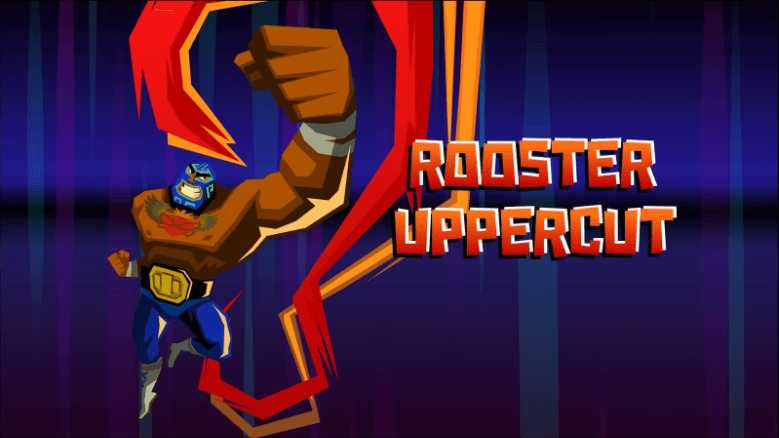
As a Metroidvania, Guacamelee! 2 excels, which is a difficult thing to do in the current marketplace where 2D Metroidvania style games are being released en masse.
At this point, even the excellent games in this genre are struggling to find an audience because there is some very real fatigue and over saturation of the market. Guacamelee! 2 is an exception to this fatigue. In fact, if anything, Guacamelee! 2 re-energized me to want to seek out more experiences like it.
Like most games of its ilk, from the very beginning the player can see areas and doors that are inaccessible. As I started traveling to my first objective I spotted a red wall with arrows on it that I couldn’t break through, a glittering silhouette of a platform that I couldn’t jump on, and an tunnel that was way too small for me to fit through. It was clear that I was going to be coming back through this area several times with new abilities that would allow me to explore more sections.
At first, I was worried that the game might have a ton of backtracking but that never really manifested. Guacamelee! 2 is designed in such a way that it never felt like I was revisiting areas too many times or getting bored with the same locations.
Indeed, the game even has a fast travel system that I only ever used once because the layout was so player-friendly that I always seemed to be in the place I needed to be for my next objective. This didn’t happen by accident. The level design and character paths in Guacamelee! 2 are superb and succeed at making the player feel smart and like they are good at discovering new things.
Abilities come in the form of both new attacks and new traversal abilities. For example, the first upgrade you get is a flying uppercut that you can use to deal major damage but it also comes in handy as a double jump. This uppercut also allows you to break through red colored obstacles. Each upgrade is much like this uppercut, having functionality in many different aspects of the game that encourages creative usage. New abilities are doled out quickly and often, making the player feel like there is potentially a new ability around every corner.
Each ability costs stamina to use so you aren’t able to just spam special ability after special ability in combat. This stamina system caused me to be careful and conservative with my abilities, waiting for the right moment to lay the hammer down in battle. It never felt like I was constrained and there were stamina upgrades hidden in chests that were paced out in such a way that I was always getting an upgrade right around the time I got a new ability.
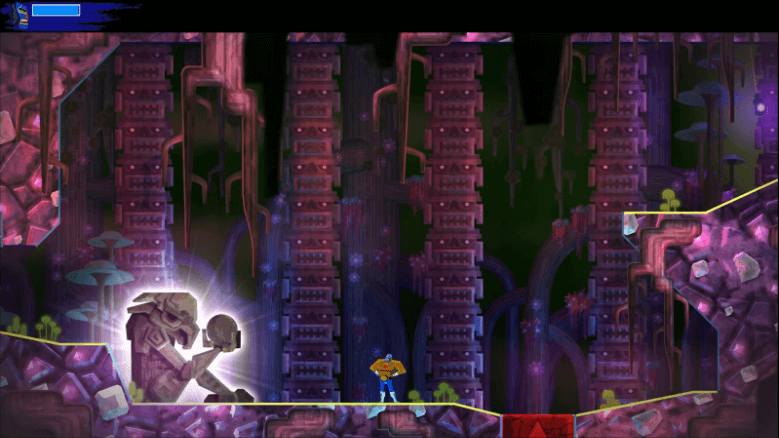
These abilities can all be upgraded via a skill-tree system. There are five separate skill-trees you can invest gold into, each tying to a specific aspect of Juan’s abilities. One tree is assigned specifically to super moves while another tree is assigned to health and stamina usage. These skill-trees involve making your abilities better and giving Juan passive abilities that will help him throughout his journey.
There is also a tree assigned specifically to Juan’s chicken skills.
That wasn’t a typo. One of the upgrades you get very early into the game allows Juan to turn into a chicken at will. A question that you might have is… why?
I initially thought that this was just a gimmick that was going to be used infrequently throughout the game, but chicken platforming is a giant part of what makes Guacamelee! 2 special.
As the chicken, you can fit into tighter spaces, move faster, and jump higher. There are even specific mini-dungeons spaced throughout the game that can only be entered and completed in chicken form, forcing the player to engage with this form on a regular basis. These challenges usually moved quicker and were more frenetic than the normal gameplay and I would look forward to these chicken dungeons because they were some of the biggest highlights of the game. Chicken-form also came with its own myriad of upgrades and super moves such as a chicken dash and the ability to glide across gaps. What initially appeared to be a humorous gag turned out to be one of the most interesting gameplay elements that Guacamelee! 2 had to offer.
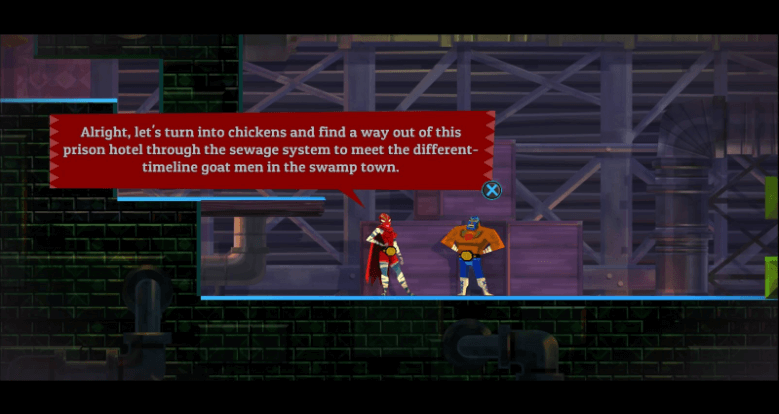
Juan and his chicken alter-ego are constantly unlocking new abilities to use and they get the opportunity to try them out frequently in combat. As the game’s title suggests, Guacamelee! 2 has you fighting a lot of enemies in rapid succession, using your abilities to deal with different types of enemies. At the outset most enemies can be dispatched with a few punchery-dos and a couple of suplexes but as you gain abilities, enemies start showing resistances general attacks and special moves must be used. This is displayed on screen by an aura that surrounds the enemy. For example, if an enemy is surrounded by a purple aura you must use your chicken dash special move on him first before any other attack will do any damage. Switching forms and strategies is a must so Juan has to be well versed with his entire arsenal in order to have any success in combat.
Combat is made unique in this game by having regular combat arenas spaced throughout the adventure. About every third or fourth room you enter will cause the room to be walled off around you and the word “LUCHA” will appear on screen. In these combat challenge rooms enemies will start phasing in and out of different realms and you will not be able to move forward until each enemy is dispatched. These rooms are cleverly crafted, each one offering unique challenges and forcing the player to use all of their abilities to succeed.
I am not someone who typically enjoys the combat in Metroidvania games. I normally come to these games for the exploration and discovery. Gucamelee! 2 had me rethinking this during my playthrough. I absolutely loved the combat in this game, and I think a big part of this had to do with the way these combat challenge rooms were set up. It almost reminded me of the Batman Arkham games more than typical 2D games. You were set up in a combat arena with a certain amount of enemies you needed to best, some requiring some advanced strategy to get past. There is a combo meter, much like the Batman games, that goes up based on your types of moves and how many enemies you strike at once and your gold reward increases based on this combo streak. I found myself having high score competitions against myself during these challenges seeing how long I could extend my combo chains. Refreshing and very rarely frustrating.
I found the boss fights, as in many games, a little underwhelming. I won’t go into specific details for sake of spoilers but, unsurprisingly, boss fights usually involved using the ability Juan had just discovered in order to beat the enemy.
All of the boss fights, up to and including the final boss, were fairly simple and uninteresting. I did not lose a life or struggle with any of the boss fights and that had nothing to do with my skill because this game killed me on a regular basis. The boss fights just didn’t offer enough of an interesting challenge to get me engaged. There were several of the combat arenas that I found more difficult and found every combat arena more interesting than any of the boss encounters.
The only aspect of the game not yet discussed that I would be remiss to not talk about is the platforming. Guacamelee! 2 is first and foremost a Metroidvania, but underneath that is an incredibly complex and intricate platformer. I was blown away by the platforming sections in this game both because of their design and because they were unexpected.
These platforming sections start out as normal platforming challenges and that you use various abilities to solve. Early on, Juan gets a power that allows him to switch dimensions and this can create some interesting platforming challenges as certain platforms will only appear in certain dimensions so the player will have to switch dimensions mid-jump to make the necessary platform appear. What starts out as fun and goofy quickly turns into intense and intricate.
By the end of Guacamelee! 2 I couldn’t stop thinking about how much these platforming sections had in common with games like Celeste and Super Meat Boy.
These games, known for their punishing difficulty and precise platform mechanics, clearly inspired platforming sections in Guacamelee! 2. These platform challenges were specifically challenging in rooms that guarded a chest with an health or stamina upgrade. I would often need to use every one of Juan – and Chicken Juan’s – abilities in quick succession in order to reach the goal.
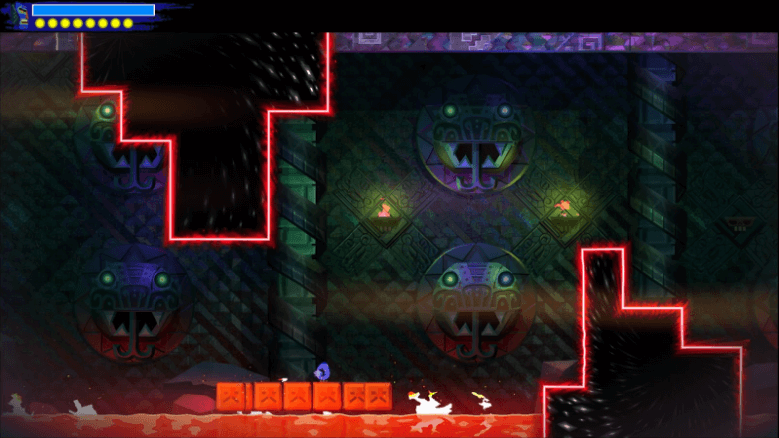
Several times approaching the game’s conclusion I was white-knuckling my controller trying to get past the chasms set before my by the developers. The cool thing was that none of these sections seemed impossible or unfair. If I fell to my death it was strictly because I did something wrong and not because the game screwed me over.
The design of these sections was set in such a way that after completing a particularly difficult sequence I felt that I had accomplished something. When I entered the next room and saw another obstacle set before me, I was excited to overcome it and not annoyed that it was in my way. This is a difficult balance to strike and I think that Guacamelee! 2 did it quite well.
All in all I spent roughly 10 hours with Guacamelee! 2, completing the campaign in just under nine. There were a couple aspects of the game that I didn’t get to check out. The entire campaign can be played in co-op, drop in and drop out style at the touch of a button. I didn’t get to play any of this but I could imagine the experience to be chaotic enough to be fun. There were some post-game challenges that I messed around with but haven’t completed yet. I’m not sure yet if I will go back to complete them or not, but the trophy hunter in me tells me that I will.
Guacamelee 2! is a Metroidvania at its heart, but when you remove the mask you will see that there is a lot more under the surface.
The ability based exploration is satisfying but it does not define the experience. The ability suite offered to the player seems deeper and larger than other games in the genre that I’ve played.
The combat is original and fun in every instance and it gave me the feeling that I needed to use every tactic at my disposal to be successful. The platforming sections are brutal in the best way and always interesting.
The story and the humor are the misses for me, and they miss big. However, the gameplay is the reason to come to Guacamelee! 2 and it doesn’t disappoint.
Despite some initial concerns, Guacamelee! 2 delivers as a heavyweight contender of a Metroidvania that shouldn’t be lost in the sea of its peers.

